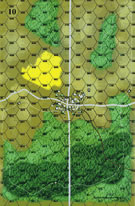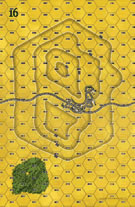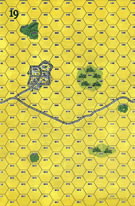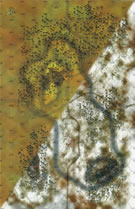|
Forward Again Romanian Soil #8 |
||
|---|---|---|
| (Defender) Germany | vs | Soviet Union (Attacker) |
| Formations Involved | ||
|---|---|---|
| Germany |  |
24th Panzer Division |
| Soviet Union |  |
16th Tank Corps |

| Total | |
|---|---|
| Side 1 | 2 |
| Draw | 0 |
| Side 2 | 0 |
| Overall Rating, 2 votes |
|---|
|
4.5
|
| Scenario Rank: --- of 913 |
| Parent Game | Romanian Soil |
|---|---|
| Historicity | Historical |
| Date | 1944-04-12 |
| Start Time | 09:00 |
| Turn Count | 30 |
| Visibility | Day |
| Counters | 231 |
| Net Morale | 0 |
| Net Initiative | 0 |
| Maps | 4: 10, 16, 19, 25 |
| Layout Dimensions | 86 x 56 cm 34 x 22 in |
| Play Bounty | 211 |
| AAR Bounty | 171 |
| Total Plays | 2 |
| Total AARs | 1 |
| Battle Types |
|---|
| Road Control |
| Urban Assault |
| Conditions |
|---|
| Off-board Artillery |
| Reinforcements |
| Terrain Mods |
| Scenario Requirements & Playability | |
|---|---|
| Battle of the Bulge | Maps |
| Eastern Front | Counters |
| Elsenborn Ridge | Maps + Counters |
| Red Warriors | Counters |
| Romanian Soil | Base Game |
| Road to Berlin | Maps + Counters |
| Introduction |
|---|
|
The German counterattack totally frustrated the Soviets, but two days later they had reorganized their forces and were ready to push forward again. Their main effort would fall on the small village of Totoesti, held by Lt. Gen. Maximilian von Edelsheim's 24th Panzer Division, a converted cavalry division with a poor fighting record. Edelsheim had greatly improved the division's performance, but he would need his troops to exceed that standard if the Axis line was to hold. |
| Conclusion |
|---|
|
The initial Soviet assault by a brigade of tanks and one of motorized infantry broke through the German lines and threatened to unhinge the Axis position. But Edelsheims's troops reacted promptly, rolling to the sound of the guns with the division's reserve battle group. The Germans pushed the Soviets back to their starting positions, and by nightfall all of the fighting positions held that morning once again contained German armored cavalrymen. |
| AFV Rules Pertaining to this Scenario's Order of Battle |
|---|
|
| 6 Errata Items | |
|---|---|

|
The reduced direct fire value of the Heer HMG became 5-5 starting with Fall of France. (plloyd1010
on 2015 Jul 31)
|

|
All SS PzIVH tanks should have a movement of 8. (Shad
on 2010 Dec 15)
|

|
The morale and combat modifiers of German Sergeant #1614 should be "0", not "8". (Shad
on 2010 Dec 15)
|

|
All SPW 251s have an armor value of 0. (Shad
on 2010 Dec 15)
|

|
The reduced direct fire value in Kursk: Burning Tigers is 4-4. (plloyd1010
on 2015 Jul 31)
|

|
Kommissars never get morale or combat modifiers. Ignore misprints. (Shad
on 2010 Dec 15)
|
| Ubermensch, or Nietzsche would have been proud. |
|---|
|
This scenario has a little bit of everything. Both sides get to attack and defend, both sides have buckets of armor, the Soviets have a ton of artillery and the Germans have leaders. In the end analysis, the leaders made the difference. But, as in most PG scenarios it is the little things that make the difference; in this case, leader draws. The game starts out with a huge force of Soviets (54 platoons of infantry and 12 of armor types) attacking two battalions of infantry supported by two platoons of assault guns. The goal of the German force is to delay and cause enough disruption, demoralization and losses to the attacking Soviets to permit their reinforcements (which arrive around the middle of the scenario) to push the Soviets back. The historical note indicates that the Germans were successful in this endevour. The Soviets have four goals. Clear the north south road to the first town, take that town, which lies astride an east west road, clear the east west road, take the eastern town and cause German losses. In the end the Soviets were only able to cause the German losses, having taking massive losses of their own to do it. In order for the Soviets to win they must push forward hard (thus the title "Forward Again"). The coming German reinforcements are quite powerful (Panthers, late model Mark IVs and mechanized infantry with the APC firepower) and if the Soviets are not in defensible positions when these reinforcements arrive, the Germans while sweep them off the battlefield. The Germans decide to play for time and set up four delay points along the north south road. The first is a small detachment containg some GREN and a 75 IG. This is swept away by the Sovets within an hour. The second is a stronger force including 4 GREN platoons, 1 HMG and 1 50mm AT, overlooking the road from a wooded rise, another GREN platoon is hiding in the light woods along the way to the town and nearby the town an assault gun is dug in. In the town itself and to the east are substantial forces including the 88mm and the mortars. Defending the eastern side of the board are two companies of infantry, the remaining assault guns, the other 50mm AT and some decent leaders. These forces are split between the large hill to the north and the town to the south. They do not expect to be involved early but they are in place to delay the Soviets if they choose an indirect approach and will joing the counterattack as it develops. The initial entry for the Soviets was notable and by turn 4 it seemed as though they would be able to push on to the town. They entered with their entire force straight down the north south road and quickly disposed of the first blocking force and had invested the larger blocking force on the wooded hill. Unfortunately for the Soviets the Germans had two of their better leaders, a captain and a sergeant, both with "2" morale modifiers. This force would remain in place and cause severe delay and losses until 3 turns after the entry of the German reinforcements and even then both leaders were able to escape. More on this later. The lone platoon was destroyed by Soviet armor but the road was blocked by 8 burning T-34s dispatched by the assault guns dug in in the fields to the northwest of the town. As the leaders and troopers continued to hold out to the north the Soviets were not able to bring sufficient force to bear on the town and the forces and leaders there were able to keep the Soviets from any lodgement in the town (two INF platoons did get into the town but were chased out by the German engineers within 15 minutes). The German reinforcements arrived immediately (on the first possible turn) and began pushing the Soviets in the fields and woods to the northwest of the town. It was during this counterattack that the Soviets acheived their one victory condition for German losses. Unfortunately the Soviets proved too disorganized to be able to counterattack in any meaningful way and the final tally remained one victory condition for a German major victory. The real victory, however, was the survival of the larger delaying force for over four hours. The reinforced company faced over a regiment of Soviet infantry and 6 platoons of T-34s and did not fail. They were ultimately overwhelmed as they were too close to the road to permit the position to remain in place and their position overlooking the road was too dangerous to the softer targets in the Soviet force. This endurance was almost entirely due to the two high morale leaders and in fact the only real degradation of the position happened after both leaders had been demoralized (on rolls of "12") and fled the area. This is a wild affair with both sides having 70-120 combat units. The Soviets have a huge superiority of force early on but they must be successful in getting into the town on the north south road. If they are unable to capture a lodgement there, they will have real trouble with the arriving reinforcements. With everything that is happening, even though in my play the early failure of the Soviets was clear and the effects crushing to the Soviet hopes, the mix of forces, the hilly and varied terrain, I give it a "5". I can't help but think of what the Soviets might have been able to to had the German leaders been a little less "supermen" |
| 0 Comments |

 RoSo007
RoSo007 









































